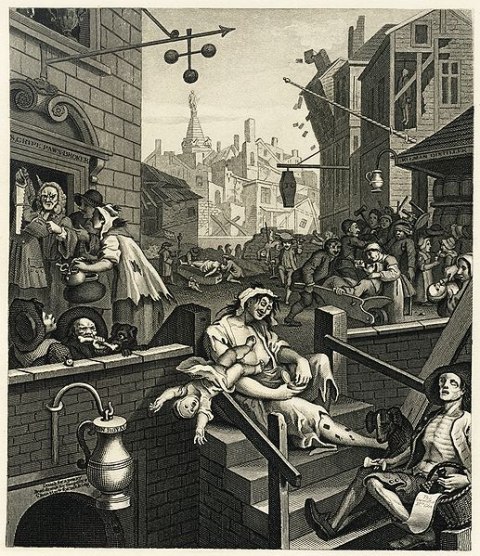I read this really interesting article about the effects of Gin on 18th Century England gave me some ideas as for the brand identity I am building for the gin. I want the identity to take on a lighthearted potentially humorous tone of voice to appeal to the younger market that for which it is intended. I think that its relatively well known past as a tormentor of its victims could be an interesting concept if used in a comical way.
Notes from article :
- Gin was the drug of choice of the mig-eighteenth century - 'the effects of gin-drinking on English society makes the use of drugs today seem almost benign'.
- Gin started out as a medicine - it was thought it could be a cure for gout and indigestion.
- It was cheap and therefore popular among the poor.
- Signs in 1730's London used to read 'Drunk for 1 penny, Dead drunk for tuppence, Straw for nothing'
- In London alone, there were more than 7,000 'dram shops' - booze shops/bars
- 10 million gallons of gin were being distilled annually in London
- Gin was drunk by barbers, pedlars, and grocers and even sold on market-stalls
- some workers were given gin as part of their wages. Duty paid on gin was 2 pence a gallon, as opposed to 4 shillings and nine pence on strong beer.
- The average person could not afford French wines or brandy, so gin took over as the cheapest, and most easily obtained, strong liquor.
- Gin rendered men impotent, and women sterile, and was a major reason why the birth rate in London at this time was exceeded by the death rate.
- The government of the day became alarmed when it was found that the average Londoner drank 14 gallons of spirit each year - so increased tax on gin.
- this put many reputable sellers out of business, and made way for the 'bootleggers' who sold their wares under such fancy names as Cuckold's Comfort, Ladies Delight and Knock Me Down - became a black market.
- Much of the gin was drunk by women, consequently the children were neglected, daughters were sold into prostitution, and wet nurses gave gin to babies to quieten them. This worked provided they were given a large enough dose.
- People would do anything to get gin…a cattle drover sold his eleven-year-old daughter to a trader for a gallon of gin, and a coachman pawned his wife for a quart bottle.
- Gin was the opium of the people, it led them to the debtors' prison or the gallows, ruined them, drove them to madness, suicide and death, but it kept them warm in winter, and allayed the terrible hunger pangs of the poorest.
- In 1736 a Gin Act was passed which forbade anyone to sell 'Distilled spirituous liquor' without first taking out a licence costing £50.
- In the seven years following 1736, only three £50 licences were taken out, yet the gallons of gin kept coming.
- The thirst for gin appeared insatiable. People sold their furnishings and even their homes to get money to buy their favourite tipple.

- The horror of the situation in London was portrayed in a print by Hogarth called 'Gin Lane'. This shows a drunken woman with ulcerated legs, taking snuff as her baby falls into the gin-vault below.
- Henry Fielding, author of the book 'Tom Jones', also delivered a pamphlet to the government stating his protest against the perpetual drunkenness of the Londoners.
- Once again the government was forced into action. A new 'Gin Act' was passed which raised the duty on drink and forbade the distillers, grocers, chandlers, jails and workhouses from selling gin.
- Gin was never again quite so much of a scourge and consumption fell dramatically through the rest of the eighteenth century.
Full article available at Historic UK.

No comments:
Post a Comment